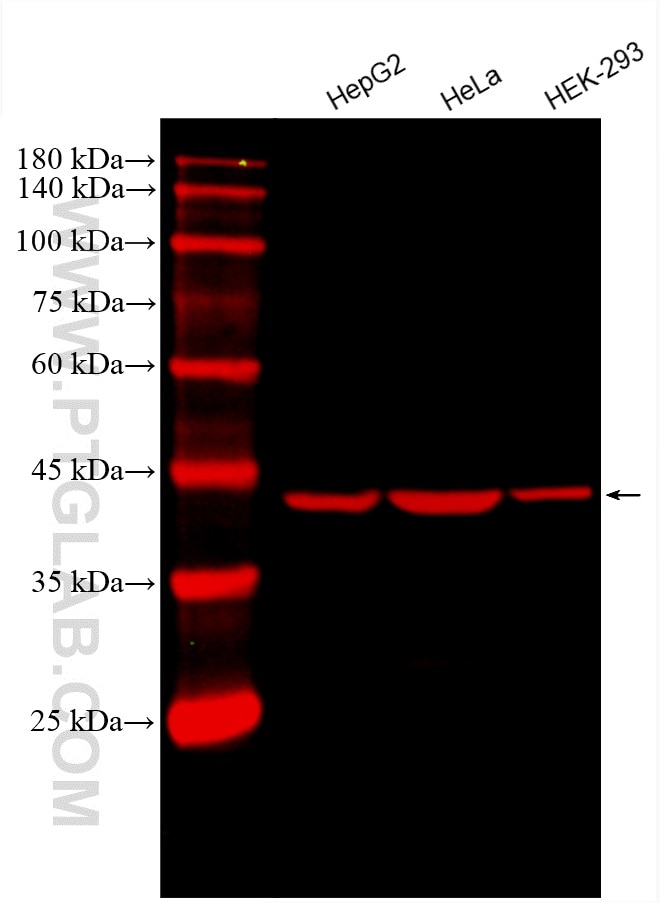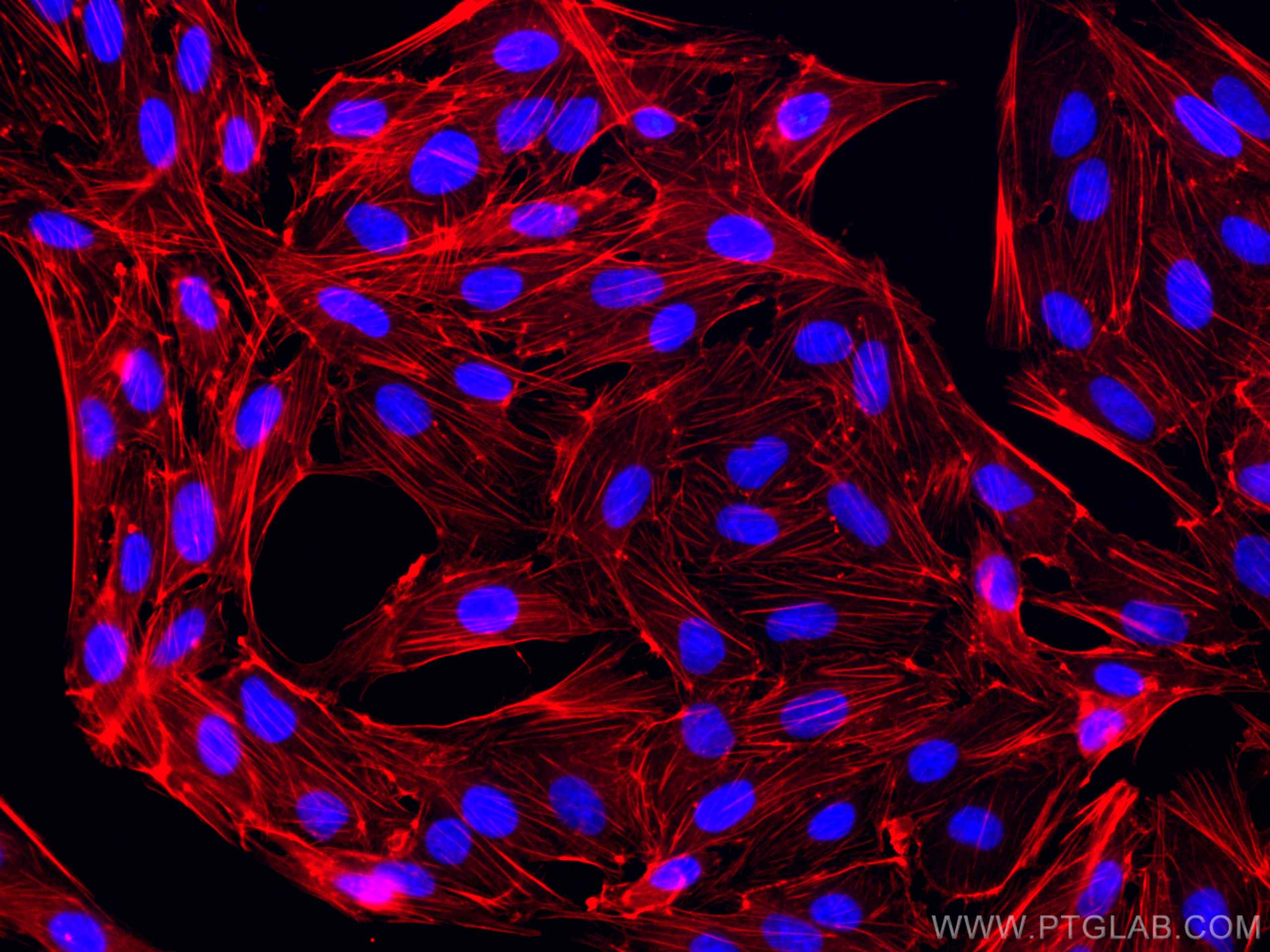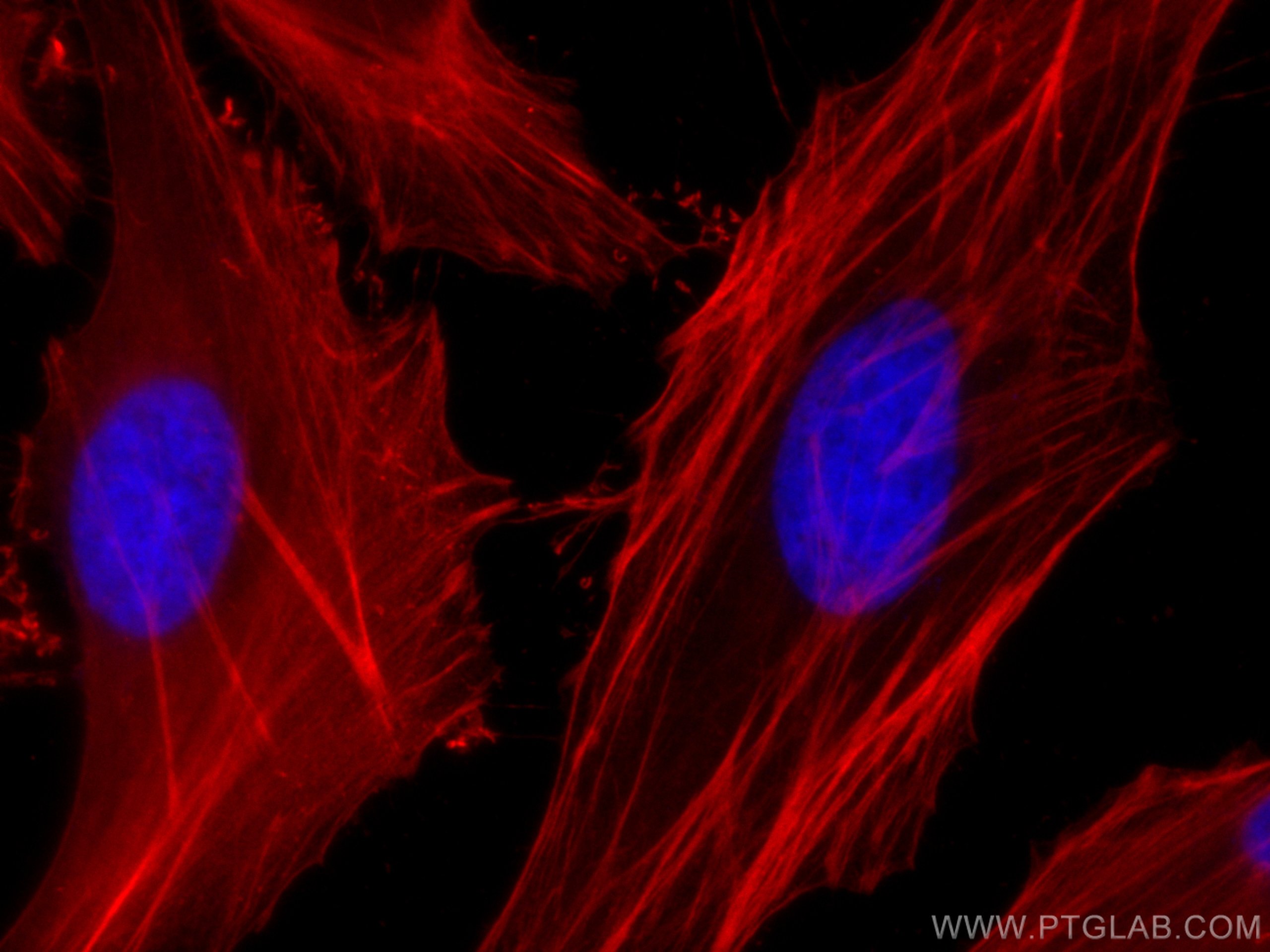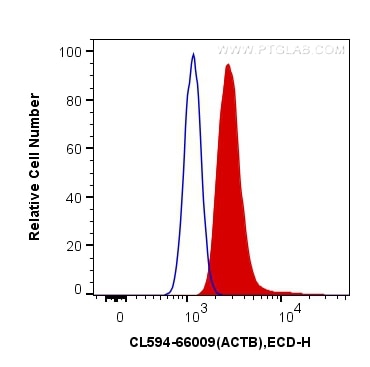Beta Actin Monoklonaler Antikörper
Beta Actin Monoklonal Antikörper für FC (Intra), IF, WB
Wirt / Isotyp
Maus / IgG2b
Getestete Reaktivität
Affe, hamster, human, Hund, Maus, Ratte, Zebrafisch
Anwendung
WB, IF, FC (Intra)
Konjugation
CoraLite®594 Fluorescent Dye
CloneNo.
2D4H5
Kat-Nr. : CL594-66009
Synonyme
Galerie der Validierungsdaten
Geprüfte Anwendungen
| Erfolgreiche Detektion in WB | HepG2-Zellen, HEK-293-Zellen, HeLa-Zellen |
| Erfolgreiche Detektion in IF | MDCK-Zellen, HepG2-Zellen |
| Erfolgreiche Detektion in FC | A431-Zellen |
Empfohlene Verdünnung
| Anwendung | Verdünnung |
|---|---|
| Western Blot (WB) | WB : 1:500-1:2000 |
| Immunfluoreszenz (IF) | IF : 1:50-1:500 |
| Durchflusszytometrie (FC) | FC : 0.80 ug per 10^6 cells in a 100 µl suspension |
| It is recommended that this reagent should be titrated in each testing system to obtain optimal results. | |
| Sample-dependent, check data in validation data gallery | |
Veröffentlichte Anwendungen
| WB | See 14 publications below |
Produktinformation
CL594-66009 bindet in WB, IF, FC (Intra) Beta Actin und zeigt Reaktivität mit Affe, hamster, human, Hund, Maus, Ratten, Zebrafisch
| Getestete Reaktivität | Affe, hamster, human, Hund, Maus, Ratte, Zebrafisch |
| In Publikationen genannte Reaktivität | human, Maus, Ratte |
| Wirt / Isotyp | Maus / IgG2b |
| Klonalität | Monoklonal |
| Typ | Antikörper |
| Immunogen | Rekombinantes Protein |
| Vollständiger Name | actin, beta |
| Berechnetes Molekulargewicht | 42 kDa |
| GenBank-Zugangsnummer | NM_001101 |
| Gene symbol | ACTB |
| Gene ID (NCBI) | 60 |
| Konjugation | CoraLite®594 Fluorescent Dye |
| Excitation/Emission maxima wavelengths | 588 nm / 604 nm |
| Form | Liquid |
| Reinigungsmethode | Protein-A-Reinigung |
| Lagerungspuffer | BS mit 50% Glyzerin, 0,05% Proclin300, 0,5% BSA, pH 7,3. |
| Lagerungsbedingungen | Bei -20°C lagern. Vor Licht schützen. Nach dem Versand ein Jahr stabil. Aliquotieren ist bei -20oC Lagerung nicht notwendig. 20ul Größen enthalten 0,1% BSA. |
Hintergrundinformationen
Actins are highly conserved globular proteins that are involved in various types of cell motility and are ubiquitously expressed in all eukaryotic cells. At least six isoforms of actins are known in mammals and other vertebrates: alpha (ACTC1, cardiac muscle 1), alpha 1 (ACTA1, skeletal muscle) and 2 (ACTA2, aortic smooth muscle), beta (ACTB), gamma 1 (ACTG1) and 2 (ACTG2, enteric smooth muscle). Beta and gamma 1 are two non-muscle actin proteins. Most actins consist of 376aa, while ACTG2 (rich in muscles) has 375aa and ACTG1(found in non-muscle cells) has only 374aa. Beta actin has been widely used as the internal control in RT-PCR and Western Blotting as a 42-kDa protein. However, the 41 kDa cleaved fragment of beta actin can be generated during apoptosis process.This antibody can recognize all the actins. The isotype of this antibody is IgG2b. And the anitbody is CL594(Ex/Em 593 nm/614 nm) conjugated.
Protokolle
| Produktspezifische Protokolle | |
|---|---|
| WB protocol for CL594 Beta Actin antibody CL594-66009 | Protokoll herunterladen |
| IF protocol for CL594 Beta Actin antibody CL594-66009 | Protokoll herunterladen |
| Standard-Protokolle | |
|---|---|
| Klicken Sie hier, um unsere Standardprotokolle anzuzeigen |
Publikationen
| Species | Application | Title |
|---|---|---|
Protein Cell The chemical reprogramming of unipotent adult germ cells towards authentic pluripotency and de novo establishment of imprinting | ||
J Clin Invest Sec13 promotes oligodendrocyte differentiation and myelin repair through autocrine pleiotrophin signaling. | ||
Hypertens Res Unilateral chemical ablation of the adrenal gland lowers blood pressure and alleviates target organ damage in spontaneously hypertensive rats | ||
Inflammation Ursolic Acid Promotes Autophagy by Inhibiting Akt/mTOR and TNF-α/TNFR1 Signaling Pathways to Alleviate Pyroptosis and Necroptosis in Mycobacterium tuberculosis-Infected Macrophages | ||
Neurochem Res Akt/mTOR Pathway Agonist SC79 Inhibits Autophagy and Apoptosis of Oligodendrocyte Precursor Cells Associated with Neonatal White Matter Dysplasia | ||
J Ethnopharmacol The licorice flavonoid isoliquiritigenin attenuates Mycobacterium tuberculosis-induced inflammation through Notch1/NF-κB and MAPK signaling pathways. |






